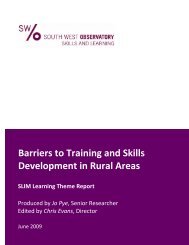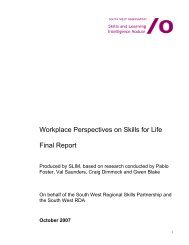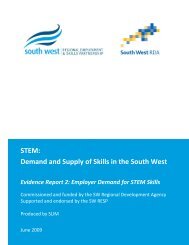Ageless at Work - Skills for Care
Ageless at Work - Skills for Care
Ageless at Work - Skills for Care
You also want an ePaper? Increase the reach of your titles
YUMPU automatically turns print PDFs into web optimized ePapers that Google loves.
Figure 5 Projected working age popul<strong>at</strong>ion by broad age group, South West, 2007<br />
to 2027<br />
1400<br />
16-19 20-24 25-39 40-49 50-SPA<br />
1200<br />
1000<br />
800<br />
600<br />
400<br />
200<br />
0<br />
2007<br />
2008<br />
2009<br />
2010<br />
2011<br />
2012<br />
2013<br />
2014<br />
2015<br />
2016<br />
2017<br />
2018<br />
2019<br />
2020<br />
2021<br />
2022<br />
2023<br />
2024<br />
2025<br />
2026<br />
2027<br />
Number of residents in each age group<br />
Source: ONS Sub-n<strong>at</strong>ional popul<strong>at</strong>ion projections<br />
The chart shows th<strong>at</strong> most of the growth in the working age popul<strong>at</strong>ion will be among the group aged<br />
between 50 and st<strong>at</strong>e pension age (currently below 60 <strong>for</strong> women and below 65 <strong>for</strong> men). This is<br />
largely because the st<strong>at</strong>e pension age <strong>for</strong> women is due to rise gradually to 65 between 2010 and<br />
2020, meaning th<strong>at</strong> more older women will be classified as of working age. Thereafter, the st<strong>at</strong>e<br />
pension age of both men and women will rise to 68 by 2046. These changes mean th<strong>at</strong> the share of<br />
the working age popul<strong>at</strong>ion th<strong>at</strong> is aged 50 and over will increase from 27% in 2007 to 33% in 2027. In<br />
1987 – twenty years ago – it was 22%. The prospect of one-in-three of the working age popul<strong>at</strong>ion<br />
aged 50 and over is already a reality in West Somerset and some parts of Cornwall, Devon and<br />
Dorset. Furthermore these ‘older’ areas are projected to age faster than younger ones – such as<br />
Exeter and Bristol – increasing the difference between the two. This means th<strong>at</strong> the age structure of<br />
the labour pool will vary significantly depending on the loc<strong>at</strong>ion of the business, requiring loc<strong>at</strong>ionspecific<br />
str<strong>at</strong>egies to fully utilise the labour and skills available to the business. The number of young<br />
labour market entrants will not change significantly over the next twenty years and will account <strong>for</strong> a<br />
falling share of the working age popul<strong>at</strong>ion. Given th<strong>at</strong> there will be a gre<strong>at</strong> deal of competition to<br />
recruit from this rel<strong>at</strong>ively small pool of labour market entrants, the adult care sector will need to<br />
explore other sources of labour – including currently under-represented groups such as men, those of<br />
st<strong>at</strong>e pension age, women returning to the labour market following absence, and migrant workers.<br />
Demographic change will also impact on the level and n<strong>at</strong>ure of demand <strong>for</strong> services. This is because<br />
the number of people in the age groups who are the heaviest users of adult social care will increase<br />
substantially. This expansion is illustr<strong>at</strong>ed in Figure 6. This shows th<strong>at</strong> the number of residents aged<br />
80 and over will double over the next 25 years, and those aged 60 to 79 will increase by almost half.<br />
In contrast, the popul<strong>at</strong>ion aged under 60 is only expected to increase moder<strong>at</strong>ely (by 12%).<br />
52<br />
<strong>Ageless</strong> <strong>at</strong> <strong>Work</strong>: Change workplace cultures, development skills. Good practice report








